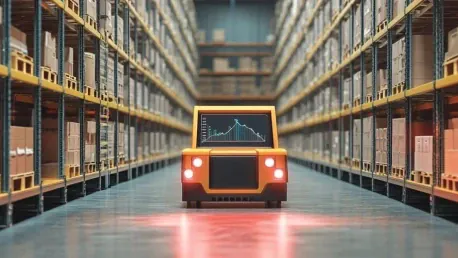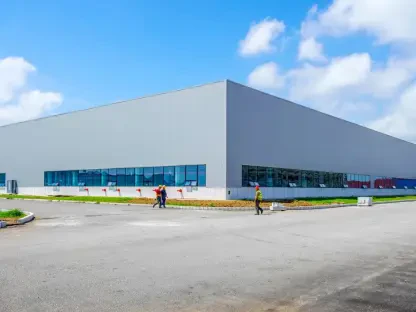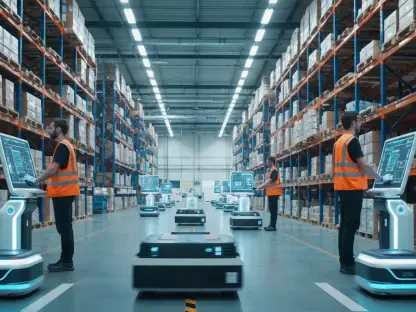The integration of Artificial Intelligence (AI) into warehouse management is not merely an evolution; it is a revolution that is transforming logistics operations. Advanced algorithms and machine learning technologies are streamlining processes, enhancing efficiency, and enabling data-driven decisions in ways previously unimaginable. As businesses recognize the profound potential of AI, they are increasingly investing in these technologies, which promise to automate routine tasks, reduce errors, and optimize resource allocation. This article delves into the transformative potential of AI in warehouse management, discussing market projections, key trends, challenges, and opportunities that lie ahead.
Projected Growth of AI in Warehouse Management
AI in warehouse management is experiencing remarkable market growth. The global market size, which was estimated at USD 2.6 billion in 2023, is projected to balloon to approximately USD 70 billion by 2033. This represents a compound annual growth rate (CAGR) of 39.0% from 2024 to 2033. This rapid expansion underscores the growing adoption of AI technologies, spurred by an urgent need for enhanced operational efficiency and precise decision-making capabilities in logistics. The complexity of modern supply chains necessitates sophisticated solutions for inventory management, demand forecasting, and logistics planning.
Businesses are increasingly turning to AI to automate routine tasks, mitigate errors, and optimize resources, thereby realizing improved productivity and significant cost savings. As companies witness the tangible benefits of AI, they are investing heavily in these innovative tools and systems. This wave of investment is expected to continue accelerating as more organizations experience firsthand the operational advantages that AI can provide. This creates a positive feedback loop that fuels further adoption and sparks continuous innovation in the sector.
Automation Integration in Warehouse Operations
A prominent trend in warehouse management is the widespread integration of automation technologies. Traditional forklifts, for example, are being retrofitted with automation capabilities, significantly enhancing their efficiency, especially during peak operational seasons. Automated systems, such as Amazon’s Kiva robots, have become commonplace, moving shelves and reducing the need for manual labor. This trend towards automation not only increases operational speed but also significantly heightens accuracy.
Additionally, the market is witnessing a surge in sophisticated robotic systems designed to handle picking and sorting tasks autonomously. These robotic solutions reduce the dependency on human workers, enabling individuals to be redeployed to more strategic roles within the warehouse. By incorporating Generative AI, logistics processes are further optimized by suggesting the most efficient warehouse layouts and inventory management strategies. This involves analyzing vast amounts of data to minimize the travel time for picking and reduce overall operational costs, thus maximizing efficiency.
Advanced Robotics Enhancing Efficiency
The advancement of robotics in warehouse management is another key trend driving efficiency and reducing operational reliance on human labor. These advanced robots are capable of performing complex tasks such as picking, packing, and sorting with minimal human intervention. By speeding up these processes and ensuring higher accuracy, these robots are revolutionizing how warehouses operate. Collaborative robots, or cobots, are also gaining traction, as they are designed to work alongside human workers.
Cobots handle repetitive and physically demanding tasks, freeing human workers to focus on more complex, decision-intensive activities. This synergy between human and robotic efforts leads to improved overall workflow and productivity. Another innovative application of AI in warehouses is the use of drones equipped with sensors and cameras for inventory scanning. These drones provide real-time updates on stock levels, ensuring better inventory management, reducing the risk of stockouts, and enhancing order fulfillment processes. The combination of these advanced technologies contributes to creating a more efficient and responsive warehouse environment.
AI in Predictive Maintenance and Real-time Data Usage
AI technologies are increasingly employed for predictive maintenance, a critical component for ensuring equipment reliability and minimizing downtime. By analyzing data from various sensors and systems, AI can predict potential equipment failures before they occur, allowing for timely maintenance interventions that extend the lifespan of machinery. Leveraging real-time data through digital twins—virtual replicas of physical assets—enables warehouse managers to closely monitor operations. Digital twins provide invaluable insights into warehouse conditions, facilitate informed decision-making, and identify areas for operational improvement.
This approach boosts productivity and reduces operational disruptions. AI-powered monitoring systems further enhance safety by offering real-time alerts to prevent accidents and ensure compliance with safety standards. This proactive approach to safety management not only mitigates risks but also creates a safer working environment for all warehouse staff. As AI continues to evolve, its application in predictive maintenance and real-time data usage will likely expand, further optimizing warehouse operations and ensuring smoother, more reliable performance.
Cost Reduction and Enhanced Decision-Making
AI’s predictive analytics capabilities play an instrumental role in preventing costly equipment failures and avoiding unnecessary downtime. By foreseeing maintenance needs and optimizing various operational processes, AI helps warehouses reduce overall operational costs while improving efficiency. The accuracy of AI-driven inventory management systems means fewer errors in the picking process and faster order fulfillment speeds. Additionally, AI tools can optimize how goods are loaded into transportation vehicles, leading to substantial savings in shipping costs and improved delivery times.
Automated returns processing is another area where AI delivers significant benefits. AI systems can efficiently categorize and process returns, reducing the need for manual labor and speeding up the handling of returned goods. This leads to faster inventory turnover and enhances customer satisfaction. The ability of AI algorithms to deliver precise demand forecasting aids warehouses in managing their inventory more effectively, ensuring they meet customer demands promptly. These advantages collectively contribute to significant cost reductions and improved decision-making processes, reinforcing the indispensable role of AI in modern warehouse management.
Challenges in AI Adoption
Despite the numerous advantages of AI in warehouse management, its adoption is fraught with challenges. Maintaining high-quality, consistent data is critical for AI to function effectively, yet many warehouses struggle with data inconsistencies. Poor data quality can hinder AI performance and limit the achievable benefits. Another significant challenge lies in integrating AI systems with existing legacy systems. Many warehouses rely on older technologies that may not seamlessly integrate with new AI solutions, necessitating substantial time and resources to achieve compatibility.
The high initial cost of implementing AI technology, including robotics and advanced systems, poses a significant barrier for many operators. These costs, coupled with the complexity of managing AI systems and training staff adequately, represent substantial hurdles to widespread adoption. Furthermore, navigating the regulatory and ethical landscape related to data use and automation can complicate AI integration. Despite these challenges, the potential benefits of AI in warehouse management far outweigh the obstacles, suggesting that overcoming these barriers is a worthwhile investment for future growth and efficiency.
Opportunities in AI for Warehouse Management
The integration of Artificial Intelligence (AI) into warehouse management represents not just an evolution, but a true revolution in logistics operations. Through advanced algorithms and machine learning technologies, AI is streamlining processes, boosting efficiency, and enabling data-driven decisions in ways that were previously unimaginable. Businesses are beginning to recognize the immense potential of AI, leading to increased investments in these cutting-edge technologies. AI promises to automate routine tasks, minimize errors, and optimize the allocation of resources far better than traditional methods.
This article explores the profound impact AI is having on warehouse management. It highlights market projections, key trends, and the various challenges and opportunities that come with adopting AI technologies. Companies that implement AI stand to reap significant benefits, including more efficient operations and lower costs. Despite the hurdles, the potential of AI in transforming warehouse management is undeniable, making it an essential focus for forward-thinking businesses aiming to maintain a competitive edge in today’s fast-paced market.









